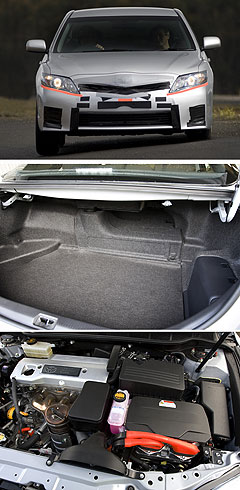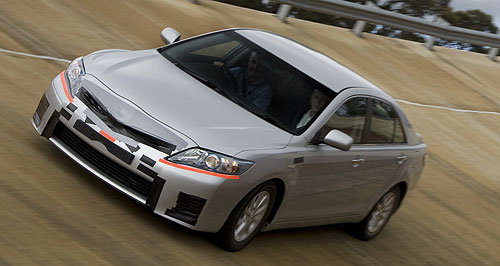Future models - Toyota - Camry - HybridFirst drive: Camry Hybrid gets Aussie tweaksTesting time: A Toyota Camry Hybrid is put through its paces at the test track ahead of its launch in February. Toyota takes opportunity to lift its upcoming local hybrid hero to new levels8 Sep 2009 THE Australian-made Camry Hybrid will not be half as dull as some might expect. GoAuto can make this bold prediction after driving a pilot version at the Linfox-owned Australian Automotive Research Centre just out of Anglesea on the Victorian coastline this week. The jury is still out on whether the first petrol-electric hybrid to be made in Australia will match the 20 per cent fuel economy gains promised, but it is certain to deliver other benefits when the highly anticipated model goes on sale in February. While the Camry Hybrid is anything but a sportscar, Toyota Australia engineers have taken an opportunity to improve its handling over the standard car. This work has paid off. A back-to-back test revealed the Camry Hybrid is a far better handling car than the entry level petrol Camry. That is not saying all that much, because the standard car is not a great example of vehicle dynamics, with its woolly steering with little feedback.  Toyota Australia engineering operations manager Phil King said the fact that the car would be built in Altona rather than Thailand as first planned was a blessing because it allowed his team to play with the set up and specification. Toyota Australia engineering operations manager Phil King said the fact that the car would be built in Altona rather than Thailand as first planned was a blessing because it allowed his team to play with the set up and specification.“This car when it was first planned was actually going to be built in Thailand so our initial planning was all built around that assumption,” he said. “Then last year when it was announced that it had been moved out of Thailand and to Australia. “That actually meant for us quite a rapid change because it has ended up being a very short development time. “It suits us because Thailand was always going to be a bit of a compromise, so from a purist product planning viewpoint we were more than happy to be able to localise it because it gives it more freedom.” That freedom included specification levels as well as more scope to make the car handle better than the existing Camry, not that Toyota is saying there is anything wrong with that car. “We got another opportunity to have another go at the car,” Mr King said. “It’s not sporty, but it is fun to drive.” Engineers worked their magic with new suspensions struts and different spring and damper rates to counter the extra 60kg of hybrid gear on board, including a front-mounted inverter and boot-mounted battery pack. The weight distribution also changed from 60/40 front/rear to 55/45 front/rear. Toyota Australia developed its own tune for the Camry Hybrid that was quite different to the version that is sold in the US and features softer suspension with less of an emphasis on body control. The Camry Hybrid features electric assisted power steering in order save additional fuel instead of the more traditional electric hydraulic system. This allowed the local team to develop and finely tune its own steering set-up. Toyota Australia has not gone to the extra length of fitting the Camry Hybrid with low rolling resistance tyres as Holden has for its Commodore, but the tyre pressures had been increased. The company has not yet released details of pricing, although officials hinted the Hybrid is unlikely to have a premium of more than $3500 over the comparable Camry model. Toyota Australia expects to sell 10,000 Camry Hybrids next year, which is around one quarter of the volume it expects to sell in Australia, but it is not yet clear if there will be one model or a range. The cars we tested were pilots produced at the company’s Altona plant and were not representative of the final product specification. We drove the current standard Camry up against the Camry Hybrid, and the first thing that stood out was the improvement in handling. The Hybrid is much more composed over the bumpy ruts of the test track. The rear seems better tied down with less tendency to float. Suspension is not overly harsh, but it is firmer, with less body roll. The changes to the steering are even more noticeable. The new system is well weighted, giving the driver good feel and an accurate indication of where the wheels are pointed. So, we’ve established the Camry Hybrid handles better than the petrol-only car, but what about performance?The Camry Hyrbrid runs a 2.4-litre four-cylinder engine, as does the standard car, but they are different. The new car runs a different combustion system, called the Atkinson cycle, and is tuned for torque and economy rather than power. Toyota Australia is yet to confirm any figures, but the Camry Hybrid is expected to have about 20 per cent more power when the electric motor is factored in and 30 per cent more torque. Even so, even with the extra powerplant this is no performance car as it was developed with economy in mind. That said, it does appear faster than the regular car from 0-100km/h. Drag races against the standard Camry saw the Hybrid win consistently, although it is unlikely to do much better than 9 seconds per 100km. It is more difficult to compare the driveability of the Hybrid and standard Camry because they are so different. You have to get used to the fact that the Camry Hybrid has an automatic Continuously Variable Transmission (CVT) rather than the regular torque-converter auto. This seamless transmission is well suited to the car, and many drivers are likely to appreciate the lack of steps between gears. However, drivers should not expect too much from the electric motor. The Camry Hybrid doesn’t appear to use electric-only power as much as the Prius hybrid. In fact, the pilot cars fired up the petrol engine as soon as the ignition button was pressed on several occasions. If you press ever-so-slightly on the accelerator you can ease up to around 40km/h before the petrol engine kicks in, but press down with any form of enthusiasm and the petrol engine fires up. A series of tests show that if you are in slow-moving stop-start traffic (for which you would usually use first or second gear for) you should be able to run in full electric mode and save a significant amount of fuel over a standard petrol car. We just didn’t have enough time or do enough kilometres for a conclusive fuel economy test. Using the instant economy data as a guide it appeared the Hybrid used around 6-8 litres per 100km when cruising. We are not sure how much the standard Camry used in the same conditions because we were driving the base car which doesn’t have a consumption indicator. The test car we drove featured a large high resolution screen, which shows the workings of the SynergyDrive system in colourful detail, and it also had the double-layered instrument cluster that glows bright blue at night for a futuristic effect. Camry Hybrid models will come with some increased insulation over the standard car and the difference is immediately evident on our test drive. New padding helps, as does an ‘acoustic’ windscreen which has an extra layer of clear sound-absorbent material. It is so much quieter on all surfaces, especially the coarse chip sections. The boot of the Camry is significantly impacted by the inclusion of the battery and its insulation ducting. There is no official measurement yet, but it appears around one third of the space has gone. While we will have to wait for more details on pricing and fuel consumption, the first impression is that the Camry Hybrid will be a competent green car which might even be a bit of fun.  Read moreAll future models Alfa Romeo Alfa Romeo Abarth Abarth Audi Audi Aston Martin Aston Martin BMW BMW Bentley Bentley Chrysler Chrysler Chevrolet Chevrolet Dodge Dodge Citroen Citroen Ferrari Ferrari DS DS Ford Ford Fiat Fiat FPV FPV Foton Foton Haval Haval Great Wall Great Wall Honda Honda Holden Holden Hyundai Hyundai HSV HSV Isuzu Isuzu Infiniti Infiniti Jeep Jeep Jaguar Jaguar Lamborghini Lamborghini Kia Kia Lexus Lexus Land Rover Land Rover Mazda Mazda Maserati Maserati Mercedes-Benz Mercedes-Benz McLaren McLaren Mini Mini Nissan Nissan Mitsubishi Mitsubishi Peugeot Peugeot Opel Opel Proton Proton Porsche Porsche Renault Renault Ram Ram Saab Saab Rolls-Royce Rolls-Royce Smart Smart Skoda Skoda Subaru Subaru SsangYong SsangYong Tesla Tesla Suzuki Suzuki Toyota Toyota Volvo VolvoCamry pricing
Motor industry news |
Click to shareToyota modelsResearch Toyota All future models Alfa Romeo Alfa Romeo Abarth Abarth Audi Audi Aston Martin Aston Martin BMW BMW Bentley Bentley Chrysler Chrysler Chevrolet Chevrolet Dodge Dodge Citroen Citroen Ferrari Ferrari DS DS Ford Ford Fiat Fiat FPV FPV Foton Foton Haval Haval Great Wall Great Wall Honda Honda Holden Holden Hyundai Hyundai HSV HSV Isuzu Isuzu Infiniti Infiniti Jeep Jeep Jaguar Jaguar Lamborghini Lamborghini Kia Kia Lexus Lexus Land Rover Land Rover Mazda Mazda Maserati Maserati Mercedes-Benz Mercedes-Benz McLaren McLaren Mini Mini Nissan Nissan Mitsubishi Mitsubishi Peugeot Peugeot Opel Opel Proton Proton Porsche Porsche Renault Renault Ram Ram Saab Saab Rolls-Royce Rolls-Royce Smart Smart Skoda Skoda Subaru Subaru SsangYong SsangYong Tesla Tesla Suzuki Suzuki Toyota Toyota Volvo VolvoCamry pricing
Motor industry news |
















Facebook Twitter Instagram